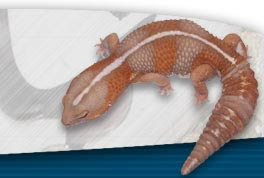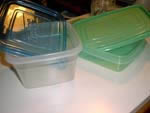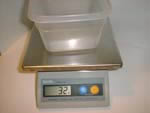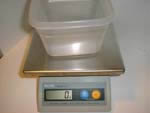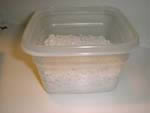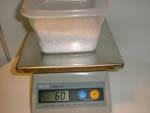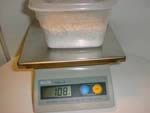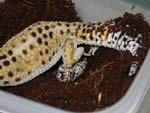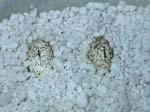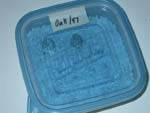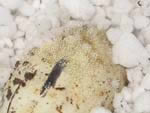

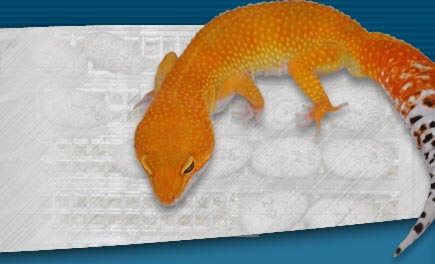

I have been asked and seen a lot of questions on how to incubate Leopard Gecko eggs. This care sheet will show you how I do it step by step:
First you need to have an egg laying container for the female. I use the Glad throw away Tupperware containers (4 cup size). You can use larger containers or even deli cups. As an egg laying medium peat moss, sphagnum moss or eco eath (coconut fiber) are all acceptable. Your females should already have one of these containers as their humid hide but make sure this is ready for your females especially after they have been with a male.
Step #1
Once your female has laid eggs you need to get the incubation container ready. I use the same size glad container the female lays her eggs in or deli cups when the glad containers are all in use. These containers hold anywhere from 4 to 12 eggs. You can use containers that hold even more eggs if you wish. I currently use containers that are air tight with no holes. This prevents the eggs or the perlite from drying out. If you do this open the container 1 to 2 times a week for air circulation. Containers that have holes can also be used. Just remember that the container may dry faster than normal especially if the incubator has a fan.
Step #2
For this next step you will need a scale in order to accurately measure how much water to add for the eggs. The scale I have has a capacity of 2000 grams and has an accuracy of 2 grams. If you can get a scale that has a “tare” feature this will make calculating everything easier. Place the container for the eggs on the scale. It weighs 32 grams. Now tare the scale and it will reset to 0. When you take the container off the scale it will register negative 32 grams.
Step #3
Now that the container is removed fill it 1/2 to 2/3 full with perlite. I prefer to use perlite as an incubation medium instead of vermiculite. The perlite seems to hold moisture better but I have used both with great success so it’s which ever you choose to use. This incubation method will work with either. Perlite or vermiculite can be purchased at an outlet such as Home Depot or a nursery.
Step #4
Place the container back onto the scale with the newly added perlite. The scale now says 60 grams. I use a ratio of .8:1 (.8 water to 1 part perlite). Since the scale says 60 grams multiply 60 times .8. This will be the amount of water you add to the container. When multiplied you get 48.
60 x .8 = 48Step #5
Now that you have done that add 60 and 48. This gives you the total amount the container will weigh once water is added. The total is 108. So the container is still on the scale and registering 60 grams. Now what you are going to do is add water until the scale reaches 108, then stop. This is the .8 to 1 ratio.
60 + 48 = 108When adding water the easiest way is to use a squirt bottle. I don't recommend using a pressured sprayer because it won't distribute the water evenly because it sprays too fast. Distribute the water as evenly as possible over the perlite surface spraying from side to side.
Step #6
Now the incubation container is ready for the eggs. Remove the egg laying container from the female and carefully dig around the eggs to expose them. Once you can see the egg add a little line on the top. This is just in case the eggs are rotated in any way. Reptile eggs can't be turned from the spot the female lays them in. If the egg is turned the embryo inside can potentially drown. If rotation occurs within the first 24 hours of the egg being laid there is usually no cause for concern as the embryo hasn’t settled yet.
Step #7
In the perlite dig a little hole for the egg. Carefully pick up the egg and transfer it to the perlite. If the female just laid the eggs they’ll be soft. If this occurs it’s best to leave them in the egg laying container for a few hours to harden up. (If they don’t firm up after a few hours they are most likely infertile.) Burry it half way so that half the egg is in the perlite and the other half is exposed above the perlite. Once in the hole move some perlite around the egg to keep it from moving.
Step #8
On the outside of the container mark the lid with any information you want to know about the eggs especially what female or group laid them.
Step #9
Place the eggs in an incubator. Now the wait begins. There are many different styles of incubators on the market. The Hova-Bator is a Styrofoam incubator and used by many breeders. I have 2 cabinet sized incubators that are set at 90 degrees fahrenheit to produce males and 82 degrees fahrenheitto produce females.
Step #10
Depending on your incubation temperatures the eggs will hatch in 30 to 105 days. You now have successfully hatched your own leopard geckos.
If you are experiencing mold on fertile eggs there is too much moisture in the container or the egg got wet. You can sprinkle a little athlete’s foot powder on the mold to help eliminate or control it. If the egg is still firm don’t toss it out as moldy eggs have been known to hatch.
Special Note
If you are incubating African fat-tail eggs you can use this same method very successfully. The only change is I use a ratio of .7:1. Fat-tail eggs don't tolerate moisture as well as leopard geckos and can mold up if too wet, even if they are fertile.

